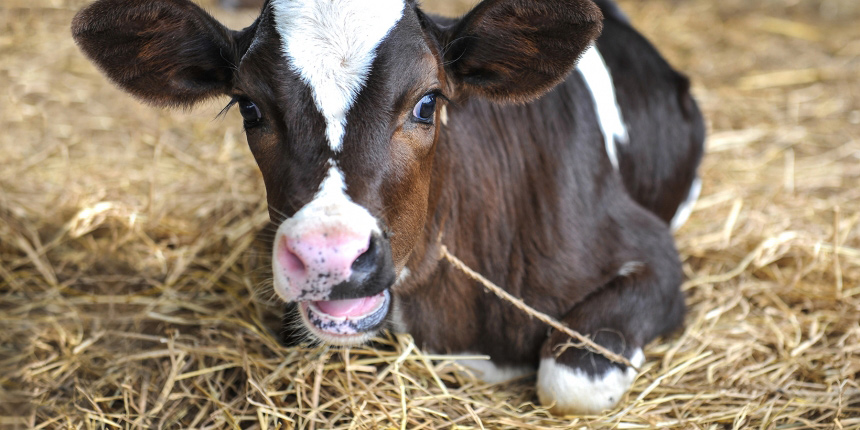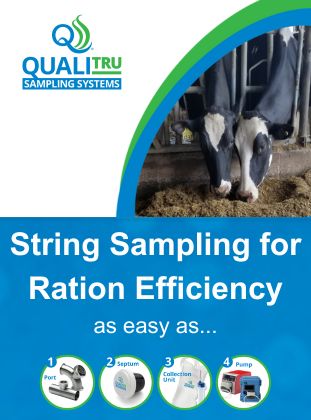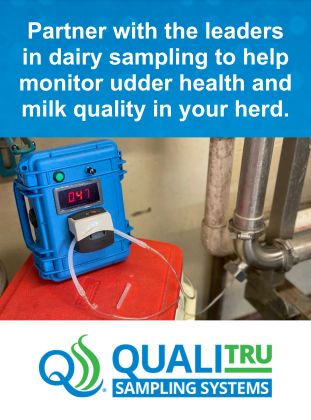Calf Diarrhea (Scours) – Dealing with Dehydration in Dairy Calves

By Heather Smith Thomas.
Many pathogens can cause scours in young calves. Intestinal infection and diarrhea can be due to certain kinds of bacteria, viruses or protozoa. Whether calves get sick is often related to multiple factors including exposure (contact with pathogens), level of immunity, and stress (such as bad weather and not enough protection from cold and wet or heat)—which can hinder the immune system.
Dr. Paul Hardes (Turtleford, Saskatchewan) says scours is generally the result of interaction between the immune system, the environment and the pathogen load. The best way to prevent scours is a clean environment for calving cows and for young calves after they are taken away from the cows, and a good vaccination program for the cows. If cows have good immunity they provide good quality colostrum to newborn calves.”
If calves can get colostrum within the first 2 to 4 hours, they obtain good protection. Colostrum from the dam is ideal, and next best is stored colostrum from your own dairy herd. The third option is commercial good-quality colostrum products.
When a young calf breaks with diarrhea, people often try to determine whether it’s due to bacteria, a virus, or protozoa. It’s hard to tell, without isolating the pathogen from a fecal sample, but age of the calf can be a clue. “If the calf is less than 5 days old we often suspect E. coli as the cause. If the calf is a bit older, such as 10 days up to 3 weeks, we tend to think it might be viral scours (rotavirus and/or corona virus), or possibly cryptosporidiosis. If the calf is more than 3 weeks old it might be coccidiosis,” says Hardes. That protozoal disease takes at least 3 weeks for coccidia to go through their life cycle within the intestinal tract and cause the damage that results in diarrhea.
With coccidiosis there is usually some blood in the feces, but not always. There will usually be oocysts in the feces, however, which might be seen when checking a fecal sample. Crypto can be harder to diagnose. Calves may pick up protozoal pathogens from feed and water contaminated with feces. Calves with scours caused by protozoa (crypto or coccidiosis), even though it’s not bacterial, often benefit from antimicrobial products.
Diarrhea in young calves (from any cause) can be a challenge because they dehydrate more readily than an older calf. Early treatment and rehydrating the calf can make a big difference in the outcome.
Dr. Derek Foster (Assistant Professor of Ruminant Medicine, Department of Population Health and Pathobiology, North Carolina State College of Veterinary Medicine) says the mainstay of treatment for scours is always fluid therapy. “For the vast majority of sick calves, it can be oral fluids, especially if they are not yet too dehydrated. My rule of thumb is that as long as the calf can get up and stand, and still has a suckle reflex, we can administer oral fluids; the calf doesn’t need intravenous fluids,” he says.
“If the calf is too weak to get up but is still lying sternal (on the breastbone, with head up) and still has a suckle reflex (able to suck your finger) you can still treat with oral fluids and milk (if the calf is unable to nurse) via tube,” says Hardes. “But if a calf is lying flat out and doesn’t attempt to get up and has a very weak or absent suckle reflex, he needs IV fluid.”
The IV fluids are crucial at this point due to the poor perfusion of the gut (lack of blood circulation) and limited absorption of oral fluids. If the calf is not treated with IV fluids it becomes weaker and unable to suckle. “Acidosis and dehydration is what kills these calves,” Hardes says.
“When treating any kind of scours, I recommend using commercial electrolytes—with the proper mix and balance of electrolytes–versus homemade mixes that may have an imbalance and might do more harm than good,” says Hardes. For example, if oral electrolyte solutions are not mixed with enough water, the extra salts pull more water out of the body and into the gut to try to dilute and balance those salts. This will further dehydrate those calves.
“Some producers simply give water to scouring calves, but this won’t work, either. Those calves have lost a lot of crucial electrolytes (via diarrhea) that need to be replaced,” he explains.
“Our recommendation for a calf with diarrhea is to provide at least 2 liters of fluids daily, in addition to whatever milk or milk replacer the calf is drinking,” says Foster. “If the calf is bright and still willing to consume milk or milk replacer, often 2 liters of additional fluid and electrolytes should correct the dehydration,” he says. In years past, veterinarians recommended holding calves off milk for 24 hours when calves had diarrhea, simply feeding electrolyte solutions, but today this is no longer advised.
“The old philosophy was that continuing to feed milk to a calf with diarrhea would irritate the gut and make the diarrhea worse, but more recent research suggests that milk doesn’t make diarrhea worse, and it helps the calf maintain strength and body weight while recovering. The calves we hold off milk tend to lose weight. We prefer to keep them on milk as long as they are up and able to suckle,” says Foster.
An oral electrolyte solution should contain the necessary electrolytes (sodium, chloride and potassium) in proper balance, plus an alkalizing agent—which is often bicarbonate. “When looking at oral electrolytes to give calves, if the calf is on milk we prefer to use an electrolyte that has an alkalizing agent other than bicarbonate. We need an alkalizing agent, but unfortunately some products on the market don’t contain one. Since the blood pH in these calves is often low, however, we need to do something about that. We appropriate electrolytes that will help correct their blood pH,” he says.
If the calf is still consuming milk or milk replacer, bicarbonate interferes with digestion. You can use a bicarbonate, but not at the same time the calf is getting the milk or milk replacer. “Some products contain acetate as the alkalizing agent instead of bicarbonate, so that’s a preferred ingredient for a calf that’s also drinking milk at the same time. Producers can talk with their veterinarian to see what might be recommended, with an appropriate alkalizing agent,” he says.
It is important to provide adequate nutrients/energy fairly often or the calf will become weak. Calves have relatively small stomachs and in general can handle only about two liters of fluid at a time. A scouring calf needs a lot of oral fluids to make up for losses through diarrhea and being off feed, but this has to be given over 24 hours in small feedings.
Hardes recommends alternating milk (or milk replacer) with the oral electrolytes/fluid, feeding one or the other every 6 hours.
Sometimes producers want to know how to tell whether a calf actually needs fluids. “If it still has diarrhea and is a little depressed and moving a bit slow, you should continue treating with fluids and electrolytes,” says Foster.
“For many cases of diarrhea, oral electrolytes once a day in addition to the milk they are drinking will be enough to keep up with fluid losses. This gives the electrolytes they need, and helps rehydrate them. Hopefully within a couple days they will be bright and happy and bouncing around again,” he says.
In serious cases where the calf is weak and not interested in food, but not yet to the point of needing IV fluids, electrolytes and oral fluids should be administered more frequently than once a day, preferably once every 6 hours. “If the calf is too weak to stand up, however, it needs IV fluids and glucose because the blood sugar has dropped too low. Some of those calves will also need antibiotics. In general we try to stay away from treating routine diarrhea with antibiotics because supportive care is often all the calf needs. As long as we can keep them hydrated, their immune system can take care of the pathogen—which is oftentimes a virus (like rotavirus or coronavirus),” says Foster. In these situations an antibiotic won’t help, and the calf simply needs supportive care.
Replacing the fluid and keeping the calf from becoming dehydrated is the most important thing. “It’s a combination of making sure the calf has enough fluids, plus the electrolytes needed, since the fluid cannot be absorbed without the proper electrolytes. Sodium is critical for absorption of water. Amino acids and glucose increase absorption of sodium, which in turn helps increase absorption of water. All these things work together to rehydrate the calf,” explains Foster.
An electrolyte product should be mixed with the appropriate amount of water to ensure that the calf gets the right amount of sodium. “If there is inadequate water the calf ends up with too much sodium and this can be a problem. These things need to be in balance. It’s also important that the calf receive something to help correct its blood pH if it’s a little acidotic. Unless we are doing bloodwork on these calves, we don’t really know for sure how acidotic they are, and we are guessing. Most of them are somewhat acidotic and we need to give bicarbonate or acetate,” he says.
The earlier you treat the calf, the quicker he will bounce back, and the fewer treatments will be needed. “If we can reverse the dehydration before the calf needs IV fluids, and keep it hydrated during the diarrhea episode, most of the time we can avoid having to resort to more intensive treatment,” says Foster. It pays to closely monitor young calves, and assess their health. Often the first clue will be the calf not feeling up to par, appearing a little dull, not as interested in suckling at mealtime—even before he breaks with diarrhea.
If the calf is already scouring and dehydrated, he’ll need fluids and electrolytes immediately and probably won’t suck a bottle. It is easier, faster and less stressful for both you and the calf to administer fluids via esophageal probe or nasogastric tube than trying to force-feed him with a bottle. “This is the best way to make sure we give the calf an adequate volume of fluid when needed,” says Foster. The calf should be given fluids until it is strong again and no longer dehydrated.
“The best way to assess how dehydrated a calf is (besides how depressed it is and whether it is willing to suckle) is by checking the eyes. As a calf becomes more dehydrated, the eyes tend to sink back in the head,” he says. Tissues around the eyes are short on fluid, giving the appearance of sunken eyes.
“We assess the gap between the eyeball and the inside corner of the eye. In a normal calf, the inside corner, eyelid, third eyelid and eyeball should all be together and touching. As the calf becomes dehydrated the eye starts to recess back into the head and there’s a gap. The bigger that gap, the more dehydrated the calf is. We use that as a rough gage to determine whether this is a mildly dehydrated calf or severely dehydrated calf. This helps us try to decide if we can get by with routine treatment–2 quarts of fluids once a day–or if we need to give the oral fluids more frequently, or if we need to give IV fluids,” says Foster.
When supportive care and fluids aren’t enough, your veterinarian may suggest adding antibiotics as well as non-steroidal anti-inflammatory medications to a scour treatment protocol. “When calves are brought to our hospital, I usually give a broad-spectrum antibiotic, not necessarily to treat the primary infection if we’re dealing with viral scours (since antibiotics won’t be effective against a virus), but to prevent a secondary bacterial infection,” says Hardes. The calf is already sick and compromised, and more vulnerable to additional infection by bacteria.



